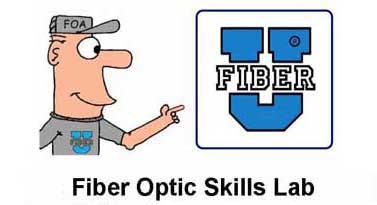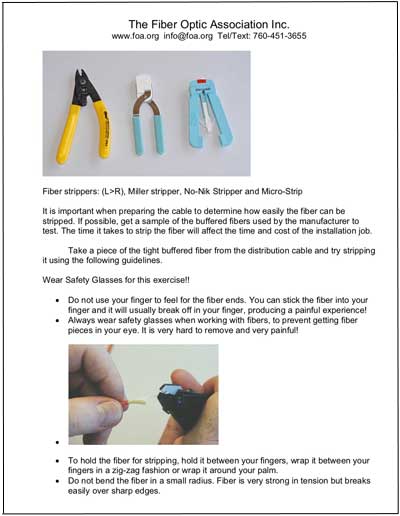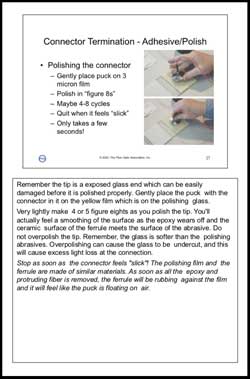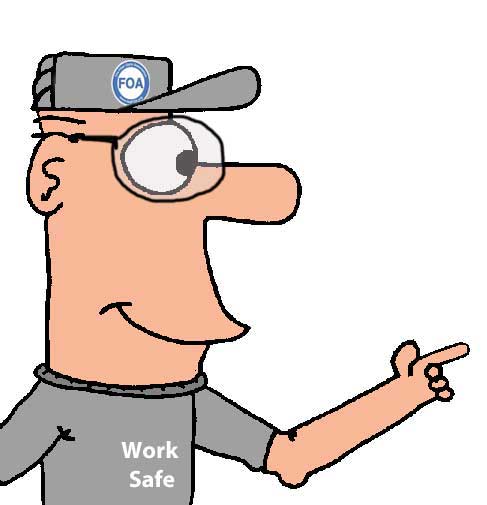


Lesson Plan: Fiber Optic Skills Lab, Introduction and OverviewOnline Self- Study ProgramIntended For:
Level:
What You Will Learn In This Basic Self-Study Program:
Reference Materials Available For This Course (see below)
Equipment You Will Need For This Program For "Hands-On" Exercises
This is not the usual online course but a "hands-on" guide. It is intended to help you as you learn new skills - the skills needed to install optical fiber cable plants. Properly done, this self-study course involves learning how to use the tools and components of fiber optics in a realistic manner. If you have your own fiber optic tools or have access to them and can get the proper components for this lab, you can use it to learn many processes used in fiber optics. If you do not have equipment, you can study these lessons to learn the processes and take a hands-on course from an FOA Approved School to get the hands-on training. If you do not have tools or equipment and want to purchase them, there is a special Fiber U Basic Skills Lab lesson has directions on how to purchase inexpensive tools online and use them to learn basic fiber optic skills. For each lesson, you must download the appropriate section of Fiber U Basic Skills Workbook and read that first. It will guide you thorough the lesson and at the end, have worksheets you should fill in to document your work on that lesson. At the end of the course, your workbooks show your completion of the course and they can be saved for future reference. Some of the processes here can be hazardous, like working with sharp scraps of optical fiber and chemicals. The first lesson is about safety - we recommend reading it carefully and posting the safety rules for everyone to see. Always wear safety glasses when doing any of these exercises and dispose of all fiber scraps properly. This course is provided for educational purposes and the reader is expected to use it as a basis for learning on their own. These guidelines are strictly the opinion of the FOA advisors responsible for its content. The FOA assumes no liability for the use of any of this material. KSAs - Knowledge, Skills and Abilities The FOA uses KSAs - knowledge, skills and abilities - to set the standards for what a technician needs to know and what skills and abilities they must have to work effectively in fiber optics. Knowledge is acquired from classroom instruction or self-study using available reference materials like textbooks, websites, videos, etc. Fiber U offers the Basic Fiber Optics online self-study program to allow self-motivated workers to gain that knowledge. Once you have gained the knowledge you need, how do you gain the skills required? On-the-job-training (OJT) is a common way of learning those skills, as is getting trained in a school with hands-on labs or from manufacturers who tech how their products are to be used. But many ask "Can those skills also be developed by an individual practicing on their own?" Certainly! Many of us in the business learned (and continue to learn) that way. Sometimes it is referred to as "learning by experience" or "learning the hard way" because it takes lots of practice and enough knowledge to understand what you do wrong so you can correct your mistakes. But do not underestimate the time needed or the frustration you will encounter. Just like learning a sport or a hobby, you will need to learn what needs to be done, get the right equipment and practice, practice, practice! How This Self-Study Program Works This Fiber U Basic Skills Lab is a companion course to the Fiber U Basic Fiber Optics self-study program. However this self-study program focuses on the hands-on processes in which fiber optic techs should become skillful. It will divide the basic skills of fiber optics into topics focused on specific areas - safety, tools, cables, splicing, termination and testing. Each topic will have a brief introduction to the subject, telling you what you should learn from that lesson, link you to reference materials in several formats: FOA YouTube Videos, pages in the FOA Online Reference Guide to Fiber Optics , especially the Virtual Hands-On (VHO) tutorials, and sometimes a chapter in the FOA Reference Guide to Fiber Optics printed textbook for you to study. When doing each exercise, it helps to watch the videos completely several times - at least once - before you attempt any hands-on exercises. You will probably find it convenient to have them ready to play while you are doing the hands-on exercises or you can use the VHO (Virtual Hands-On) tutorials which may be easier because you do not need to pause a video. The VHO tutorials will show you step-by-step how to do the exercises using the processes we have learned from manufacturers and instructors as well as have developed in our own labs. It is very important to follow the steps in order to properly complete the exercises. If the components you are using have specific instructions from the manufacturer, those instructions should have priority and be followed. It is also important to be consistent - in order to produce consistently good results, you must follow the same process exactly every time. We cannot overemphasize this point! Work in a space that is open, clean, well-lighted and where you will not be disturbed to avoid distractions. It is important you concentrate on the exercises and follow each step carefully. Allow plenty of time to complete the exercises without interruption, especially termination. During the termination exercise, for example, you will use adhesives which must be used quickly. If you interrupt the process, it will probably lead to a failure and a waste of time and supplies. It's Good To Have A Partner On The Course We have found that students in classes work better in pairs. Working in pairs allows sharing tools and supplies, plus it allows two students to compare notes and help each other. A partner is especially good when trying to learn a new procedure, as one can be reading or viewing the procedure prompting the other who follows the procedure and does the exercise. If you are part of a company, the tools and test equipment can be shared among users in the company and supplies bought in larger quantities (or maybe leftovers from other fiber jobs used.) Of course, if you have an experienced tech who can help you, that's the best way to learn. Learning More and Developing Skills Online courses can help you develop the knowledge of a subject like fiber optics but unless you do all the hands-on labs described here, you are not going to get the hands-on experience needed to develop the skills used in working with the actual components. If you are just getting started in fiber optics, you should consider attending an FOA-Approved school where you will be trained in hands-on labs to develop the skills needed to be successful in fiber optics. This program has been developed as a cooperative effort of many volunteer advisors from the FOA. If you have comments or suggestions on how to improve it, please contact us at info@thefoa.org. Before You Start - Prerequisites And Equipment This "skills" course assumes you have knowledge of fiber optic termination and splicing. If you are new to fiber optics, you should first complete the "Fiber U Basic Fiber Optics" course before attempting the hands-on exercises here. In order to follow these exercises, you will need tools, test equipment and various fiber optic components. If you work for a company engaged in fiber optic installation or manufacture, the required parts should be available from your employer or you can purchase them from many vendors recommended in Lesson 3. If you do not have any equipment, a special Fiber U Basic Skills Lab lesson has directions on how to purchase inexpensive tools online and use them to learn basic fiber optic skills. The organization of this self-study program is designed to make your learning these skills safely and efficiently. Thus we start with a lesson on safety that is vitally important for your learning experience to be safe and efficient. Please follow this lesson carefully, then get the proper safety equipment and use them all the time.
Familiarize yourself with the safety procedures and follow them all the time. Always wear safety glasses. Be careful when working with sharp tools. We recommend working on a black table mat to make it easier to see the fiber (and any scraps). It is best to work on tile or concrete floors, not carpet. If you drop fiber scraps into carpet they can be very hard to find or pick up with a vacuum cleaner. Clean up after your exercises carefully. Some of the scrap you generate can be harmful, such as fiber ends, so we recommend you not work anywhere near food preparation or children’s play areas! Place clean paper over your work area to keep from harming the worktable surface. Download a FOA safety poster for your work area. Reference Materials You can take this Fiber U Online course using online or printed reference materials. Besides the FOA materials shown below that are used in this course, you should also use manuals and videos from the manufacturers of the equipment and components you are using which you can find on their websites. The Fiber U Fiber Optic Skills Workbook is a "lab manual" for this course. Divided into sections for each lesson plan, it will help you prepare for the hands-on exercises and help you understand the processes in the VHOs (Virtual Hands-On) step-by-step tutorials on each process. This is a PDF file so you can view it online or print it.  Download the list of recommended fiber optic technician's tools and print a copy for your reference. It is a comprehensive listing and not all may be applicable to the work you do. Check with each lesson to see what is needed for that lesson. FOA YouTube Videos FOA has over 100 YouTube Videos that cover many topics including the hands-on processes covered in this self-study program. All lesson plans include FOA YouTube video lectures on the topic.  FOA Online Reference Guide to Fiber Optics VHO "Virtual Hands On" Tutorials take a "step-by-step" approach to the hands-on processes covered in this self-study program. They are a good way to teach yourself the processes here - watch the video for the overview then follow the steps in the VHO web pages. This is a PDF file so you can view it online or print it.  All lesson plans include links to the FOA Guide pages on relevant topics. Most lesson plans will also reference FOA printed textbooks.  Ready?  Let's
get started! Let's
get started!Lesson Plan: Read the materials linked on each lesson plan before going to the next lesson. After reading the workbook section and VHO tutorial and watching the videos, complete the exercises using all the tools and components types available to you. As you finish each section, fill in the worksheet in the back of the Workbook Section. Your completed worksheets are the records of your having successfully completed the exercises.
NEW: Purchase inexpensive equipment online and use it for hands-on lessons including building an actual fiber optic data link. Go here.  Get a "Certificate of Completion" When You Complete The Course After you complete complete all six lessons of the Fiber U Basic Skills Lab Fiber Optics online self-study course, you can now take an online exam and, when you pass the exam, get a "Certificate of Completion" for this course. You should complete all lessons including taking the quiz ("Test Your Comprehension") at the end of every lesson. When you think you are prepared, you can take an online exam for a nominal fee ($20) which will give you a "Certificate of Completion" for this course. Take the Test to Get Your Certificate of Completion For This Course Please note: receiving this Fiber U Certificate of Completion does not include FOA certification or membership but it does become documentation of your knowledge of fiber optics and should be part of your portfolio of documented knowledge, other training and work experience that can qualify you to apply for FOA direct CFOT certification through the FOA "Work to Cert" or "OJT-to-Cert" program. This information is provided by The Fiber Optic Association, Inc. as a benefit to those interested in teaching, designing, manufacturing, selling, installing or using fiber optic communications systems or networks. It is intended to be used as an overview and/or basic guidelines and in no way should be considered to be complete or comprehensive. These guidelines are strictly the opinion of the FOA and the reader is expected to use them as a basis for learning, as a reference and for creating their own documentation, project specifications, etc. Those working with fiber optics in the classroom, laboratory or field should follow all safety rules carefully. The FOA assumes no liability for the use of any of this material. |
||
| Remote |
| Table of Contents: The FOA Reference Guide To Fiber Optics (C)2021, The Fiber Optic Association, Inc. |